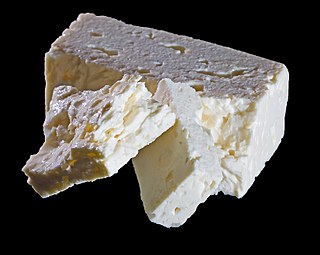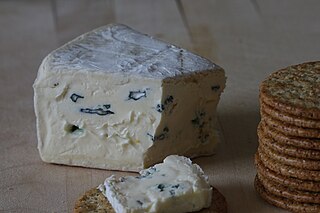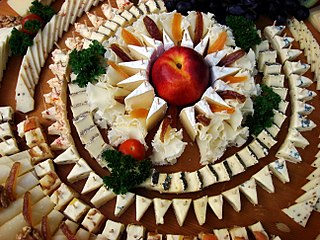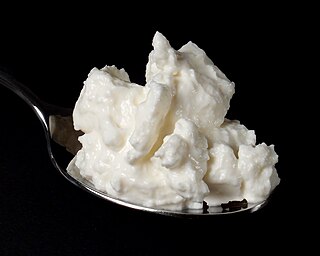
Cheddar cheese is a natural cheese that is relatively hard, off-white, and sometimes sharp-tasting. Cheddar originates from the English village of Cheddar in Somerset.

Wensleydale is a style of cheese originally produced in Wensleydale, North Yorkshire, England, but now mostly made in large commercial creameries throughout the United Kingdom. The term "Yorkshire Wensleydale" can only be used for cheese that is made in Wensleydale. The style of cheese originated from a monastery of French Cistercian monks who had settled in northern England, and continued to be produced by local farmers after the monastery was dissolved in 1540. Wensleydale cheese fell to low production in the early 1990s, but its popularity was revitalized by frequent references in the Wallace and Gromit series.

Brie is a soft cow's-milk cheese named after Brie, the French region from which it originated. It is pale in color with a slight grayish tinge under a rind of white mould. The rind is typically eaten, with its flavor depending largely upon the ingredients used and its manufacturing environment. It is similar to Camembert, which is native to a different region of France. Brie typically contains between 60% and 75% butterfat, slightly higher than Camembert.

Cottage cheese is a curdled milk product with a mild flavor and a creamy, heterogenous, soupy texture. It is made from skimmed milk by draining curds, but retaining some of the whey and keeping the curds loose. An important step in the manufacturing process distinguishing cottage cheese from other fresh cheeses is the adding of a "dressing" to the curd grains, usually cream, which is largely responsible for the taste of the product. Cottage cheese is not aged.

Stilton is an English cheese, produced in two varieties: Blue, which has Penicillium roqueforti added to generate a characteristic smell and taste, and White, which does not. Both have been granted the status of a protected designation of origin (PDO) by the European Commission, requiring that only such cheese produced in the three counties of Derbyshire, Leicestershire and Nottinghamshire may be called Stilton. The cheese takes its name from the village of Stilton, now in Cambridgeshire, where it has long been sold.

Feta is a Greek brined white cheese made from sheep's milk or from a mixture of sheep and goat's milk. It is soft, with small or no holes, a compact touch, few cuts, and no skin. Crumbly with a slightly grainy texture, it is formed into large blocks and aged in brine. Its flavor is tangy and salty, ranging from mild to sharp. Feta is used as a table cheese, in salads such as Greek salad, and in pastries, notably the phyllo-based Greek dishes spanakopita "spinach pie" and tyropita "cheese pie". It is often served with olive oil or olives, and sprinkled with aromatic herbs such as oregano. It can also be served cooked, as part of a sandwich, in omelettes, and many other dishes.

Blue cheese is semi-soft cheese with a sharp, salty flavor. It is made with cultures of the edible mold Penicillium, giving it spots or veins throughout the cheese in shades of blue or green. It carries a distinct smell, either from the mold or from various specially cultivated bacteria such as Brevibacterium linens, which also causes foot odor and other human body odors.

Cambozola is a cow's milk cheese that is a combination in style of a French soft-ripened triple cream cheese and Italian Gorgonzola.

Gloucester is a traditional, semi-hard cheese which has been made in Gloucestershire, England, since the 16th century. There are two varieties of the cheese, Single and Double; both are traditionally made from milk from Gloucester cattle. Both types have a natural rind and a hard texture, but Single Gloucester is more crumbly, lighter in texture and lower in fat. Double Gloucester is allowed to age for longer periods than Single, and it has a stronger and more savoury flavour. It is also slightly firmer. The flower known as lady's bedstraw was responsible for the distinctively yellow colour of Double Gloucester cheese.

Pikehall is a small village in the Derbyshire Dales consisting of a few dozen households and a handful of farms. The population of the village is included in the civil parish of Hartington Nether Quarter. The A5012 road runs through the middle, dividing the village in half. The village is home to the annual Y Not Festival.

Shropshire Blue is a cow's milk cheese made in the United Kingdom.

Saint Agur is a blue cheese made with pasteurised cow's milk from the village of Beauzac in the Monts du Velay, part of the mountainous Auvergne region of central France. Developed in 1988 by the cheese company Bongrain, it is made from pasteurised cow's milk, enriched with cream, and contains 60% butterfat, qualifying it as a double-cream cheese. Aged for 60 days in cellars, the cheese becomes stronger and spicier as it ages.

Cheese is a dairy product produced in wide ranges of flavors, textures, and forms by coagulation of the milk protein casein. It comprises proteins and fat from milk. During production, milk is usually acidified and either the enzymes of rennet or bacterial enzymes with similar activity are added to cause the casein to coagulate. The solid curds are then separated from the liquid whey and pressed into finished cheese. Some cheeses have aromatic molds on the rind, the outer layer, or throughout.

There are many different types of cheese. Cheeses can be grouped or classified according to criteria such as length of fermentation, texture, methods of production, fat content, animal milk, and country or region of origin. The method most commonly and traditionally used is based on moisture content, which is then further narrowed down by fat content and curing or ripening methods. The criteria may either be used singly or in combination, with no single method being universally used.

Stichelton is an English blue cheese. It is similar to Blue Stilton cheese, except that it does not use pasteurised milk or factory-produced rennet. The name comes from a form of the name of Stilton village in the 1086 Domesday Book (Stichiltone/Sticiltone), as the name Stilton cannot legally be used for the cheese.

Dovedale, sold as Dovedale Blue, is a blue cheese. It is named after the Dovedale valley in the Peak District, near where it is produced.
Milk Link was a large dairy company in the United Kingdom. It was the UK's largest dairy cooperative and the UK's largest producer of cheese. In 2012 the company merged with Arla Foods.

Quark or quarg is a type of fresh dairy product made from milk. The milk is soured, usually by adding lactic acid bacteria cultures, and strained once the desired curdling is achieved. It can be classified as fresh acid-set cheese. Traditional quark can be made without rennet, but in modern dairies small quantities of rennet are typically added. It is soft, white and unaged, and usually has no salt added.

















